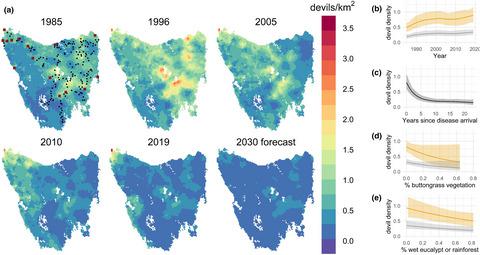当前位置:
X-MOL 学术
›
Ecol. Lett.
›
论文详情
Our official English website, www.x-mol.net, welcomes your feedback! (Note: you will need to create a separate account there.)
Quantifying 25 years of disease‐caused declines in Tasmanian devil populations: host density drives spatial pathogen spread
Ecology Letters ( IF 8.8 ) Pub Date : 2021-02-27 , DOI: 10.1111/ele.13703 Calum X Cunningham 1 , Sebastien Comte 1, 2 , Hamish McCallum 3 , David G Hamilton 1 , Rodrigo Hamede 1, 4 , Andrew Storfer 5 , Tracey Hollings 6, 7 , Manuel Ruiz-Aravena 8 , Douglas H Kerlin 3 , Barry W Brook 1, 9 , Greg Hocking 10 , Manna E Jones 1
Ecology Letters ( IF 8.8 ) Pub Date : 2021-02-27 , DOI: 10.1111/ele.13703 Calum X Cunningham 1 , Sebastien Comte 1, 2 , Hamish McCallum 3 , David G Hamilton 1 , Rodrigo Hamede 1, 4 , Andrew Storfer 5 , Tracey Hollings 6, 7 , Manuel Ruiz-Aravena 8 , Douglas H Kerlin 3 , Barry W Brook 1, 9 , Greg Hocking 10 , Manna E Jones 1
Affiliation

|
Infectious diseases are strong drivers of wildlife population dynamics, however, empirical analyses from the early stages of pathogen emergence are rare. Tasmanian devil facial tumour disease (DFTD), discovered in 1996, provides the opportunity to study an epizootic from its inception. We use a pattern‐oriented diffusion simulation to model the spatial spread of DFTD across the species' range and quantify population effects by jointly modelling multiple streams of data spanning 35 years. We estimate the wild devil population peaked at 53 000 in 1996, less than half of previous estimates. DFTD spread rapidly through high‐density areas, with spread velocity slowing in areas of low host densities. By 2020, DFTD occupied >90% of the species' range, causing 82% declines in local densities and reducing the total population to 16 900. Encouragingly, our model forecasts the population decline should level‐off within the next decade, supporting conservation management focused on facilitating evolution of resistance and tolerance.
中文翻译:

量化塔斯马尼亚恶魔种群 25 年疾病引起的下降:宿主密度驱动空间病原体传播
传染病是野生动物种群动态的强大驱动力,但是,很少有病原体出现早期的实证分析。塔斯马尼亚袋獾面部肿瘤病 (DFTD) 于 1996 年发现,为从一开始就研究动物流行病提供了机会。我们使用面向模式的扩散模拟来模拟 DFTD 在物种范围内的空间传播,并通过联合模拟跨越 35 年的多个数据流来量化种群效应。我们估计野恶魔的数量在 1996 年达到 53,000 只的峰值,不到之前估计的一半。DFTD 在高密度区域快速传播,在低宿主密度区域传播速度减慢。到 2020 年,DFTD 占据了该物种范围的 90% 以上,导致当地密度下降 82%,总种群数量减少至 16 900 只。
更新日期:2021-04-14
中文翻译:

量化塔斯马尼亚恶魔种群 25 年疾病引起的下降:宿主密度驱动空间病原体传播
传染病是野生动物种群动态的强大驱动力,但是,很少有病原体出现早期的实证分析。塔斯马尼亚袋獾面部肿瘤病 (DFTD) 于 1996 年发现,为从一开始就研究动物流行病提供了机会。我们使用面向模式的扩散模拟来模拟 DFTD 在物种范围内的空间传播,并通过联合模拟跨越 35 年的多个数据流来量化种群效应。我们估计野恶魔的数量在 1996 年达到 53,000 只的峰值,不到之前估计的一半。DFTD 在高密度区域快速传播,在低宿主密度区域传播速度减慢。到 2020 年,DFTD 占据了该物种范围的 90% 以上,导致当地密度下降 82%,总种群数量减少至 16 900 只。



























 京公网安备 11010802027423号
京公网安备 11010802027423号